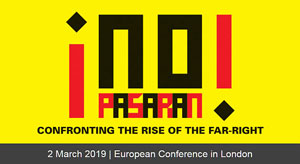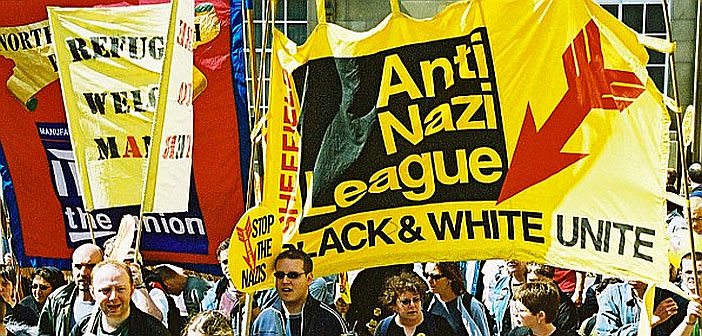Source: Open Democracy
We need a new generation who are aware of the anti-fascist legacy, assimilate it and surpass what went before.
Any readers of the recent “Populism” series in the Guardian might justly have put down their newspaper in a condition of utter disrepair. We were told that 25 percent of Europeans vote for populist parties. To which could be added the success of the far right in the US, India, and now Brazil. Among the many problem with the Guardian’s approach is that it left no space for resistance to the right. The populists have the support of the people, and anyone who disagrees can do no better than vote for the same technocratic and authoritarian neo-liberal politics which enabled the growth of the right.Here, I want to discuss something different: an anti-fascist movement in recent history which rather than seeing workers as its enemy actively recruited them.
The first main part of 1970s anti-fascism was a musical campaign Rock Against Racism. Launched in 1976 in reaction to an interview with David Bowie in which he called Adolf Hitler the first rock and roll superstar, and a drunken concert in Birmingham at which Eric Clapton announced his support for Enoch Powell, RAR was a collective of musicians, designers and grassroots politicos engaging with the nascent punk scene.
By 1979, the campaign had organised over 300 gigs and thirteen local Carnivals. Its 1979 Militant Entertainment Tour, advertised with the image of a giant rhino and the slogan, ‘Nazis are No Fun,’ featured 40 bands at 23 concerts. The tour covered some 2,000 miles on the road, culminating in a six-hour finale at Alexandra Palace. Given that nearly a quarter of million people attended just the first largest Rock Against Racism Carnivals, held in London in April and September 1979, it seems likely that around half a million people altogether were involved in some sort of RAR event.
RAR organisers repeatedly chose to allow young skinheads into their events, even at the risk of the organisers’ safety. RAR cultivated the band Sham 69 even though their supporters interrupted gigs to chant, “What we Got? Fuck All. National Front.” When fascists attacked RAR stages they were repulsed. Artists such as Sham’s Jimmy Pursey argued with their own supporters. The gigs ended with black performers, Aswad, Burning Spear or Misty in Roots. Challenged about the decision to allow racists into a gig at Middlesex Poly, RAR founder Red Saunders replied, “This is Rock Against Racism. The white working class and a reggae band and we’ve brought them all together.”
It was the same story in Leeds, whose RAR club cultivated wavering white skins, and in Birmingham where skinheads danced to soul classic Liquidator, while chanting “British Movement, British Movement.” Local organiser Sheryl Garratt recalls arguing with her opponents, even giving skinheads a lift home, “They were National Front in the same way as I was left-wing. It was like a vague unease that things weren’t right and life wasn’t fair.”
When the far right took to the streets, the anti-fascists of the 1970s saw no option but to confront them. At key moments such as the Battles of Lewisham or Southall, police shielded right-wing events, with the result that anti-fascists found themselves having to challenge both the National Front and the state. The dangers could hardly have been greater. Three thousand police were employed at Southall, a hundred of them on horseback, and seven hundred arrests were made. One demonstrator, an anti-racist teacher Blair Peach, was killed by a blow from a police officer.
Yet physical resistance sapped the National Front. Over a period of three years, it went from welcoming confrontation (with its supporters boasting, “The Front knows how to defend itself”), to avoiding it wherever possible. From turning out 800 supporters at Lewisham in August 1979, its core shrank. After Lewisham recalls Joe Pearce, then the organisers of Youth National Front, “the older, respectable NF supporters would stay away.” By Southall in April 1979, barely two dozen supporters of the Front (including Pearce himself) could be mobilised to defend their party.
Combative anti-fascism was popular with working class people. Among the supporters of the Anti-Nazi League – launched after Lewisham, to defend anti-fascists from the criticism that by attacking the Front they had gone too far – were thirty national unions, and several hundred shop stewards committees’ and other local branches, with particular groups of support among blue-collar workers in unions including the miners’ NUM, the dockers’ TGWU and the firefighters’ FBU.
Indeed, for all their description of the National Front as “Nazis”, the campaigners of the 1970s engaged with the reality that, unlike the movements of the 1930s, the Front was unable to sustain a street presence and increasingly relied on elections as the one experience which could hold together an increasingly fractious alliance of Holocaust deniers, ultra-conservatives, and people with no broader politics than anti-migrant racism.
Anti-fascists campaigned against National Front election candidates, distributing leaflets connecting the likes of John Tyndall and Martin Webster to the politics of fascism, and persuading to potential Front voters to break with them. The anti-fascists’ vindication came in the 1979 election where – after years of out-polling the Liberal Party – National front candidates obtained an average of just 1.3 percent of the vote.
Finally, nothing here should be taken as a particular endorsement of any one tradition on the present-day left. Indeed that was one of the things which the 1970s generation did so well: bringing people together across the ideological dividing lines which normally separate the left. Those searching for a successor to the creative energy of Rock Against Racism are as likely to find it among the Corbynite filmmakers at Novara Media, or in the pop-up unions organizing among digital workers as they are among the continuity campaigns who are trying hardest to copy the punk-reggae synthesis of forty years ago.
The left won’t defeat today’s tech-savvy and electoral right by relaunching the Anti-Nazi League. What the moment demands, rather, is people who know this history, and learn from it, in order to move away from it. And who, by shedding elements of the 1970s synthesis, recreate what was most essential to it. We need a new generation who are aware of the anti-fascist legacy, assimilate it and surpass what went before.
David Renton’s new book Never Again: A History of Rock Against Racism and the Anti-Nazi League 1976-1982 is published by Routledge.
02 March 2019 London | !No Pasaran! Confronting the Rise of the Far-Right
 !No Pasaran! Conference in London bringing together activists from across Europe and beyond to discuss and organise against the rise of the far-right.
!No Pasaran! Conference in London bringing together activists from across Europe and beyond to discuss and organise against the rise of the far-right.

